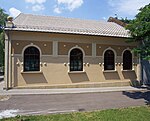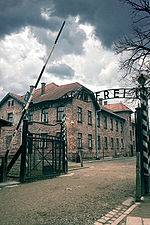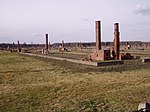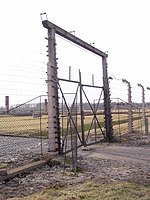Auschwitz concentration camp (German: Konzentrationslager Auschwitz, pronounced [kɔntsɛntʁaˈtsi̯oːnsˌlaːɡɐ ˈʔaʊʃvɪts] ; also KL Auschwitz or KZ Auschwitz) was a complex of over 40 concentration and extermination camps operated by Nazi Germany in occupied Poland (in a portion annexed into Germany in 1939) during World War II and the Holocaust. It consisted of Auschwitz I, the main camp (Stammlager) in Oświęcim; Auschwitz II-Birkenau, a concentration and extermination camp with gas chambers; Auschwitz III-Monowitz, a labour camp for the chemical conglomerate IG Farben; and dozens of subcamps. The camps became a major site of the Nazis' Final Solution to the Jewish question.
After Germany initiated World War II by invading Poland in September 1939, the Schutzstaffel (SS) converted Auschwitz I, an army barracks, into a prisoner-of-war camp. The initial transport of political detainees to Auschwitz consisted almost solely of Poles (for whom the camp was initially established). For the first two years, the majority of inmates were Polish. In May 1940, German criminals brought to the camp as functionaries established the camp's reputation for sadism. Prisoners were beaten, tortured, and executed for the most trivial of reasons. The first gassings—of Soviet and Polish prisoners—took place in block 11 of Auschwitz I around August 1941.
Construction of Auschwitz II began the following month, and from 1942 until late 1944 freight trains delivered Jews from all over German-occupied Europe to its gas chambers. Of the 1.3 million people sent to Auschwitz, 1.1 million were murdered. The number of victims includes 960,000 Jews (865,000 of whom were gassed on arrival), 74,000 non-Jewish Poles, 21,000 Romani, 15,000 Soviet prisoners of war, and up to 15,000 others. Those not gassed were murdered via starvation, exhaustion, disease, individual executions, or beatings. Others were killed during medical experiments.
At least 802 prisoners tried to escape, 144 successfully, and on 7 October 1944, two Sonderkommando units, consisting of prisoners who operated the gas chambers, launched an unsuccessful uprising. After the Holocaust ended, only 789 Schutzstaffel personnel (no more than 15 percent) ever stood trial. Several were executed, including camp commandant Rudolf Höss. The Allies' failure to act on early reports of mass murder by bombing the camp or its railways remains controversial.
As the Soviet Red Army approached Auschwitz in January 1945, toward the end of the war, the SS sent most of the camp's population west on a death march to camps inside Germany and Austria. Soviet troops entered the camp on 27 January 1945, a day commemorated since 2005 as International Holocaust Remembrance Day. In the decades after the war, survivors such as Primo Levi, Viktor Frankl, and Elie Wiesel wrote memoirs of their experiences, and the camp became a dominant symbol of the Holocaust. In 1947, Poland founded the Auschwitz-Birkenau State Museum on the site of Auschwitz I and II, and in 1979 it was named a World Heritage Site by UNESCO.












